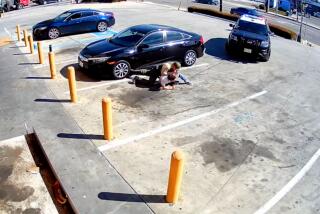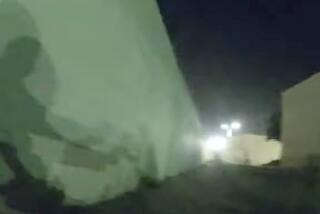Inquiry Uncovers No Ill Will Between Scanlan, Robins
- Share via
SANTA ANA — Despite concerns that race may have played a role in the accidental shooting death of a black sheriff’s deputy by a white officer, documents released Wednesday show the Orange County district attorney’s office turned up no evidence to indicate animosity between the two.
While the records detail how investigators concluded that Deputy Brian P. Scanlan showed “grossly negligent behavior” during the incident, they offer no clear explanation of why criminal charges were not brought by a grand jury against him for shooting and killing deputy Darryn Leroy Robins in an impromptu training exercise Christmas Day.
By law, transcripts of the Orange County Grand Jury’s proceedings remain secret, leaving critics with lingering doubts about the circumstances surrounding Robins’ death.
“There are more questions that are raised in my mind than answered,” said Eugene Wheeler, who heads 100 Black Men of Orange County, a business and civic group. “We are still searching for answers, still searching for the truth and justice.
“Prosecutors saw something that caused them to believe they should prosecute,” he said. “If (Scanlan) was negligent and it cost someone their life, there should be some action.”
Voluminous reports compiled by the district attorney--including dozens of interviews, lab findings, crime scene analyses and an autopsy report--appear to corroborate Scanlan’s recollection of the shooting.
In the end, however, prosecutors investigating the shooting were forced to rely heavily on Scanlan, the only person to witness firsthand one of the most bizarre incidents in the history of the Orange County Sheriff’s Department. Robins, the only other person who knew what happened in a deserted parking lot behind a Lake Forest movie theater, was pronounced dead shortly after he was shot in the face.
Many critics also remain skeptical, however, that Dist. Atty. Michael R. Capizzi’s office could complete an independent review of the case because of the close relationship between his office and the Sheriff’s Department. They still question how aggressively investigators pursued an indictment against Scanlan and wonder how a routine training session could go so terribly awry.
Robins, the training officer in the exercise, was black. Scanlan, who played the role of an officer who had stopped a car, is white.
“A separate body should have handled it,” said Pastor Van Roberson, president of the Baptist Minster Fellowship Conference of Orange County. He has helped form a coalition of black leaders to press for more information about the shooting.
“Something still is not right about all this. It’s heartbreaking to know that a deputy dies at the hands of another officer and nothing is being done,” Roberson said.
Assistant Dist. Atty. John D. Conley said he is well aware of such criticism, but believes it is misplaced.
“This investigation is as thorough as we can make it,” he said, adding that Wheeler, who was interviewed by authorities as part of the probe, could not point to evidence that race was a factor in the shooting or the subsequent investigation. Another anonymous tip that the shooting was intentional also could not be proved, he said.
“My own speculation is that there are people out there who will say ‘this is white, racist, John Birch Society Orange County, and it must be racist,’ ” Conley said. “That is unfortunate.”
Indeed, many deputies who worked closely with Scanlan and Robins say the two were close friends, according to interviews with sheriff’s deputies released Wednesday. They believe the shooting was an accident that will forever haunt Scanlan.
But at least one female deputy who trained with Scanlan said she heard him make “ethnic comments and innuendos in her presence,” a report shows.
Deputy Trisha Davis said Robins once warned her to stay away from “cowboys” like Scanlan because “they’ll either get you hurt or in trouble,” according to her statements to authorities. Davis said, however, that she did not believe race was a factor in the shooting.
Investigators interviewed 45 people, including Scanlan and 37 other sheriff’s deputies, as well as seven civilian witnesses. Their reports, which stretched hundreds of pages, included forensic tests, blood tests, autopsy results, a ballistics analysis and numerous other tests.
Yet for investigators, the case was clearly a difficult one, given the lack of eyewitnesses. Arriving at the site of the shooting, which shattered the calm of Christmas Day, they found a gruesome scene: the bloodied front seat of Robins’ patrol car, speckled with bits of flesh and several of the critically wounded officer’s teeth.
After combing the car, parking lot and the deputies’ weapons for fingerprints and gunpowder residue, and examining the bullet’s trajectory, investigators found themselves trying to reconstruct the mishap based largely on Scanlan’s recollections.
Video cameras posted in patrol cars captured some of the day’s events, but not the actual shooting. Investigators interviewed two deputies awaiting their turns at Robins’ training session; they were at the scene, but were around a corner and did not actually witness the shooting. They questioned residents of the area who heard gunfire.
Blood tests turned up no evidence of drug use or alcohol use among the deputies on the day of the incident.
Conley said the key to the case was Scanlan’s own statements to police.
“We were in a position that no one else saw the shooting but him, of course,” Conley said. “But there was no evidence that contradicted him, no evidence that it was anything other than an accident.”
The incident was serious enough, however, for prosecutors to ask the grand jury to return a manslaughter indictment against Scanlan for “aggravated, reckless and grossly negligent” behavior by training with a loaded weapon in clear violation of department policy.
The Orange County Grand Jury, after reviewing much of the evidence, including Scanlan’s videotaped interview, declined to return an indictment March 10. The rare rejection of a prosecutor’s request for an indictment angered activists all over again.
As part of the investigation, Conley said, investigators aggressively pursued claims that race may have played a role in the shooting.
Robins “was shot because he was black? These guys were friends!” Conley said. “Was this a deliberate shooting? No. Was (Scanlan) thinking ‘Oh, good, I’ve got him alone now so I can kill him?’ It’s all such wild speculation.”
Throughout the investigation, Robins’ widow has been supportive of Scanlan.
What is clear is both Robins and Scanlan were violating department policy at the time of the shooting: Scanlan, by training with a loaded weapon, and Robins, by using a so-called “backup” gun that apparently startled Scanlan.
The investigation revealed that Robins had in the past staged other unplanned training sessions, using his backup weapon or toy guns.
But other elements of the investigation still trouble critics.
For example, the reports show that a registered nurse at Saddleback Memorial Medical Center, where Robins died, heard deputies at the scene talk about “taking care of the statement,” a comment that the nurse considered unusual.
Scanlan and the other two deputies at the scene also washed their hands before tests could be performed to detect gunshot residue, and one of the deputies handled Scanlan’s gun after the shooting, but before investigators arrived, according to the interviews.
Wheeler and Roberson claim that correspondence from the district attorney’s office during the investigation appears to accept Scanlan’s version of the incident, a claim that Conley denies.
“I just can’t say it enough, there’s just something that’s not right about this case,” Roberson said.
“It just doesn’t make sense,” Wheeler said. “Something is missing.”
More to Read
Sign up for Essential California
The most important California stories and recommendations in your inbox every morning.
You may occasionally receive promotional content from the Los Angeles Times.














